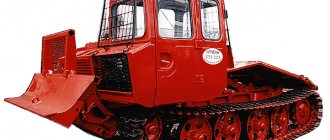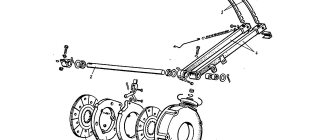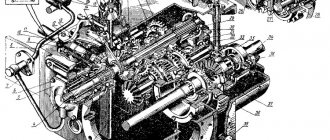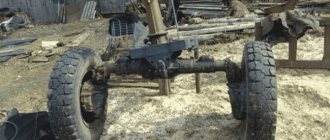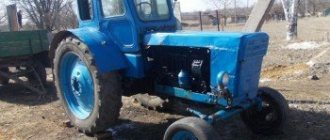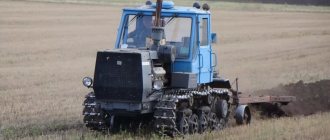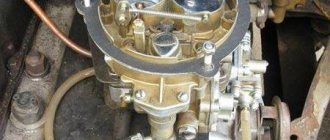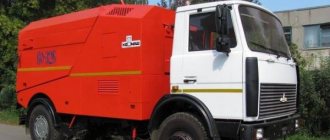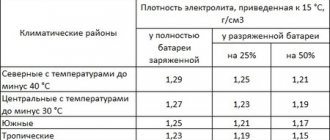The DT-75 tractor is a legend of the agricultural industry, an indispensable piece of equipment for working in the fields in the spring and autumn. This is an inexpensive, durable, crawler-mounted machine for plowing and cultivating land. Considering that the last copies of this model were released back in 2009, and the equipment in circulation is 40 years old, compliance with the maintenance regulations for the DT-75 tractor helps maintain the mechanisms in uninterrupted condition and reduces repair costs.
Maintenance regulations for the DT-75 tractor
According to the regulations, servicing the DT-75 tracked vehicle is similar to working with other self-propelled equipment. There are three mandatory types of maintenance:
- shift;
- seasonal;
- periodic (1, 2, 3).
Every shift
Before starting a shift, the tractor driver checks:
- operation of control devices, hydraulics and lighting systems;
- engine functionality, while assessing extraneous noise;
- level of fuel and technical fluids.
Before accepting the tractor, the machine is cleaned of dirt, the strength of the external components is checked, as well as the tightness of the connections in order to prevent air leaks. Next, you should eliminate all detected faults and add filtered oil to the tanks of the main and starting engines. Be sure to check the oil level in the engine crankcase, fuel pump housing and its regulator housing. If the readings are low, add oil and then check the water level in the radiator.
Seasonal service
Seasonal maintenance of the DT-75 tractor is carried out when preparing the machine in the fall and spring. The main purpose of the work is to change oil and technical fluids at the appropriate viscosity for the season. The regulations provide for the washing of tanks, sedimentation tanks, fuel drives and filters. Be sure to change the fine filter elements. The power system is filled with winter diesel fuel.
If the car is being prepared in the fall, then the screw of the RR-315DG relay regulator is set to position 3 “Winter”. The density of the electrolyte in the battery is adjusted to the winter standard according to the climate. The cooling system is filled with an antifreeze compound. Be sure to insulate the engine and battery, for which special covers are used. The cabin is also insulated. In the spring, the reverse operations are performed, transferring the machine to summer mode.
Periodic maintenance
Periodic maintenance of the DT-75 tractor is regulated by the requirements of GOST 20793-2009 and GOST 7751-2009:
- TO-1 – 125 operating hours;
- TO-2 – 500 operating hours;
- TO-3 – 1000 operating hours.
The first and second maintenance are carried out in a garage or repair shop, the third can be carried out at the mill. The foreman is appointed responsible. It is prohibited to operate the equipment without periodic maintenance.
TO-1 provides:
- all types of shift inspection work;
- checking the current oil level;
- lubrication of the linkage mechanism and bearings;
- cleaning the air intake mesh;
- checking the ventilation system;
- measuring the battery electrolyte level;
- control of belt tension in the fan;
- removing accumulated sludge and air from the fuel system.
Second maintenance of the DT-75 tractor chassis units:
- changing the oil in the crankcase of the main and starting engines;
- bearing lubrication;
- disassembling and washing the air cleaner;
- checking the condition of the coarse fuel filter;
- washing the fine fuel filter and replacing paper filter elements every 1440 hours of operation;
- checking and adjusting the tension force of the linkage mechanism extensions and the gaps between the rocker arms and valves;
- checking and adjusting control levers and brake pedals, track fingers, rear axle brakes;
- checking the condition of electric drives and DC generator contacts;
- Battery charge level measurements.
TO-3:
- all procedures from the first two examinations;
- complete oil and grease change;
- removing and cleaning the starter and generator;
- wetting the felt wick;
- cleaning the cylinder head and checking the valves for tightness;
- cleaning and washing of injectors with testing the quality of fuel atomization and pressure at the beginning of injection;
- bench testing and adjustment of the fuel pump;
- checking the operation of control devices;
- checking the operation of the tractor at idle speed.
Technical care No. 1
It is necessary to perform all operations included in the daily maintenance, with the exception of point 11, as well as the following series of works:
- The tractor needs to be washed.
- Check the current oil level and, if necessary, add it: into the axles of the suspension carriages, the hydraulic system tank, the hubs of the guide wheels, support rollers, balancers of the support rollers, the housing of the main bevel gear of the rear axle and gearbox, into the housings of the power take-off shaft gearbox (if the tractor has a drive mechanism for agricultural machinery), final drives, and a torque multiplier.
- Lubricate the crossbar of the central (upper) link of the linkage mechanism, the water pump bearings, the upper axis of the linkage mechanism, the release bearing of the main clutch, as well as the front bearing of the torque multiplier. To do this, you can use USs or US-2 grease.
- Clean the water intake mesh; wash the air cleaner reflector and cassettes with diesel fuel; the cassettes must also be moistened in diesel oil; tighten and check for leaks the ejector connections, engine intake pipes and air cleaner mounts.
- Inspect the ventilation holes of the plugs and terminals, check the current electrolyte level in the battery. If necessary, clean the surface of the battery, wire tips and oxidized terminals. Lubricate the tips and non-contact parts of the terminals with technical petroleum jelly. Clean the ventilation holes in the battery cell plugs and fill the battery water with distilled water. Check its fastenings for strength.
- Check the belt tension in the fan and, if necessary, adjust it.
- Drain the accumulated sediment from the fuel coarse filter and the main engine fuel tank. Remove air from the fuel supply system and fill it.
- Clean the ventilation hole in the tank cap located on the main engine and the tank plug on the starting engine.
- Oil that has accumulated in the following areas: rear axle, torque multiplier dry bays, and flywheel housing must be drained.
Important! The full-flow centrifuge should be flushed, the number of rotor revolutions checked and its cover should be cleaned after every maintenance No. 1 or, in other words, after every 120 hours of operation. But if work is carried out in conditions of high air temperature or other difficult conditions, then these actions are carried out every 60 hours.
Maintenance of the clutch of the DT-75 tractor
Maintenance of the clutch of a caterpillar tractor involves lubrication, adjustment and timely replacement of worn friction linings. The clutch is checked every 240 hours of operation or when the gap between the heads of the long arms of the release levers and the end of the release clutch sleeve is less than 1.5 mm. The adjustment is adjusted to 2.5-3.5 mm, the permissible difference in the gap is no more than 0.3 mm.
A gap of 2 mm is set between each thrust screw “34” and the intermediate disk. The full stroke of the coupling provides +4 mm to the gap. If during maintenance slipping of the main clutch is detected, then check the degree of oiling or deformation of the friction linings of the driven discs. To fix the problem, the clutch is disassembled, washed and the discs are replaced. In order not to disturb the balancing, the bolts located on the outside of the thrust disk are not removed.
When maintaining the clutch of the DT-75 tractor, the clutch should be engaged smoothly, but at the same time quickly. This avoids shock loads and wear on power transmission parts.
Spare parts
As for repairs, one of the unpretentious tractors is the DT 75 (bulldozer), spare parts for which can be purchased both from the main manufacturer (for example, the Volgograd Tractor Plant or Agromash), and from its dealers and alternative manufacturers. One option currently used is to use Chinese-made or remanufactured parts. It is clear that in this case you should not count on long-term or high-quality performance of such spare parts and the bulldozer as a whole.
Maintenance of the chassis of the DT-75 tractor
The chassis system of the DT-75 tractor includes suspension, guide wheels with spring shock absorbers, support rollers and tracks. When servicing this complex, the suspension carriages are checked and adjusted, in particular the axial movement (play) of the track rollers in the bearings. When the rollers and rings of tapered roller bearings wear out, the axial movement of the rollers increases. To adjust according to measurements, reduce the number of shims on each side evenly. Next, check the bearings. When the indicators are normal, the axis of the rollers turns tightly.
The chassis maintenance regulations do not provide for adjustment of the axial movement of the suspension carriages on the frame axles. In this case, it is necessary to control the amount of axial play in order to determine the reliability of fastening of threaded connections and the degree of wear of the surfaces of the carriages.
During maintenance, parts are cleaned of dirt and old grease, and the condition of all seals is checked. Adjust the guide wheels. To do this, remove the chain and manually pump the wheels. If adjusted correctly, there will be no radial play in the bearings. If there is a gap, the bearings themselves need to be adjusted.
A mandatory step is to check the track tension. With low tension, which occurs due to wear of the holes in the eyelets of the links and pins, wear of the engagement elements occurs. When adjusting, do not exceed the tension limit, as this can lead to stress in the eyelets of the links, which also entails wear on the links and pins. Increased tension affects the efficiency of the caterpillar drive, increases fuel consumption and reduces the traction power of the tractor.
Maintenance No. 3
- Before putting the tractor for technical maintenance, you should remove scale and sludge from the engine cooling system, and also wash it and the steam-air valve in the water radiator.
- Assess the general technical condition of the tractor, identify its economic and power indicators.
- Carry out periodic maintenance actions No. 2 (with the exception of points 2 and 3 from maintenance No. 1 and No. 2).
- Drain the oil in the fuel pump, wash its housing, regulator, torque multiplier gearbox, starting motor, final drives, power take-off shaft, rear axle final drive and gearbox, line and tank of the hydraulic attachment system.
- Replace the grease in the front bearing of the torque multiplier.
- The shafts of the pedals and control levers, the upper axis of the linkage mechanism, the axis of the servo mechanism lever and the traverse of the central (upper) link of the linkage mechanism.
- Remove the starter and generator from the engine, disassemble them, remove dirt and dust. If necessary, clean the commutator and change the brushes; rinse and lightly oil the shaft (band threads and journals) and starter bearings; change the lubricant in the generator bearings.
- Moisten the felt wick that lubricates the magneto breaker cam in oil.
- If necessary, remove and clean the cylinder head from the engine, check the tightness of the valves and grind them in. If there is no need to remove the cylinder head, then the valve mechanism is removed, the cylinder head mounting nuts are checked and tightened, after which the valve mechanism is installed in place and the valve clearances are adjusted.
- The injectors are removed from the engine, washed and cleaned of carbon deposits. Then they should be checked for the quality of fuel atomization and injection start pressure. If the fuel injectors are faulty, they are sent to a workshop for repair.
- Check the fuel pump with injectors and regulator on a specially designed stand in the workshop, adjust, check the fuel injection timing on the engine.
- If necessary, adjust the units of the engine lubrication system, electrical equipment, and hydraulic attachment system.
- Check the functioning of control devices.
- Check and adjust the release mechanism and clutch of the starting motor, bearings of the road wheels and idler wheels.
- Disassemble the cabin fan electric motor and clean the graphite dust from the collector, and also clean it if necessary.
- Check and swap drive wheels and tracks.
- Pour new oil into the housings and regulator of the fuel pump, final drive gearbox, torque multiplier, starting motor, hydraulic system tank, power take-off shaft gearbox.
- Check the functioning of the tractor mechanisms under load and at idle.
Important! After every maintenance service No. 3, or, in other words, 1920-2000 hours of operation, it is necessary to check the size of deposits in the cavity of the third crankpin journal of the crankshaft. You should also clean the cavities of all the others, and if this is not required, then tighten the nuts securing the connecting rod and main bearings, clean the pan and the oil intake screen.
